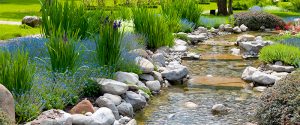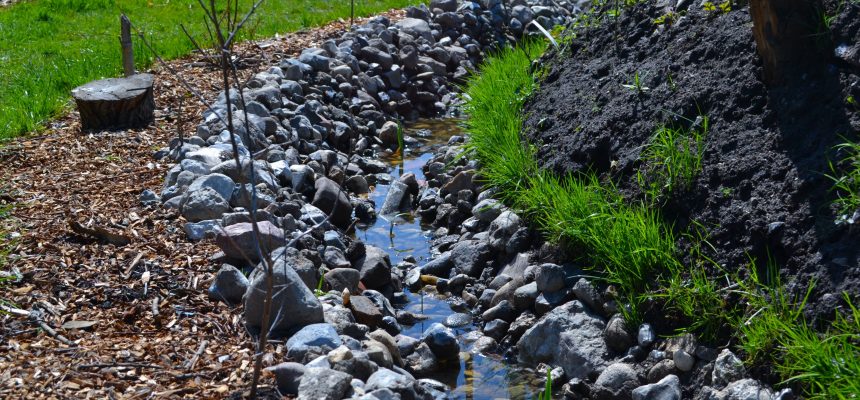With unpredictable weather and precipitation patterns becoming more of a rule than the exception to it, landscape solutions that are adaptable to a wide array of weather circumstances are a necessity.
Excess water in the landscape, particularly standing water in the springtime, can be a hazard to trees and perennials alike; both rot and a lack of oxygen to the roots can strain or even kill plants that are not physiologically adapted to living in water-saturated circumstances.

Channelling water with earthworks can take the pressure of seasonal flooding off of gardens and grass planes: a novel and ecologically-friendly earthworks solution for channeling water is a bioswale.
Essentially, a bioswale is a vegetated or rock-lined channel with a mild slope, in which silt, water, and other components of runoff can settle. As the runoff water percolates through gravel, soil, plant roots, and finally subsoil, it is filtered.
Often, these structures are meandering, which allows for sediment to settle as the water moves, however, bioswales can essentially take the form of a long drainage ditch.
Bioswales not only provide a place for water to accumulate, they also aid in recharging groundwater reserves. Vegetation that is specialised towards growing in water-saturated soil often hyperaccumulates pollutants like heavy metals that are present in runoff. This allows harmful compounds to break down gradually, instead of bioaccumulating in water and soil.
If carefully-planned and well-landscaped, a bioswale or similar earthworks structure can be both a beautiful and functional addition to any landscape, no matter the size.
For example, a bioswale lined with riprap, gravel, or rock can have the appearance of a creek in the spring, and a dry creekbed in the summer.
Alternatively, a vegetated bioswale can be home to plants like semi-aquatic irises–like native flag irises (Iris pseudacorus)–which in addition to thriving in water, also phytoremediate it.
Even during the seasons in which the swale is “empty” the lower grade of the structure will naturally create a microclimate of more water-saturated soil, so moisture-loving plants can be planted in a bioswale or on the banks of it, while plants that don’t tolerate excess water are relieved from it.
Importantly, a bioswale also provides habitat and resources for beneficial insects, as well as birds and other small animals. Most will enjoy having drinking or bathing water–however temporary as it settles–as well as relatively undisturbed nooks and crannies between rocks and vegetation that provide shelter and warmth.
In essence, a bioswale is an attractive and environmentally-friendly addition to a landscape, that can help any garden weather the extremes of seasonal changes in precipitation.
Posted in Landscaping, News
